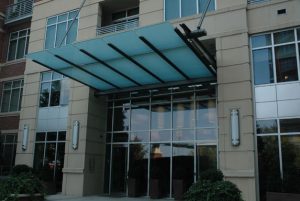In addition to being an entirely recyclable material, glass has the obvious advantage of transparency to increase the use of natural light. Natural light is free, so “daylighting” can replace up to 70-80% of the use of electric lighting, and more evenly distribute sunlight throughout a space. Plus, studies show that natural light is proven to increase worker productivity and job satisfaction.

Different types of window treatments and grades of glass affect the amount of light transmission through a window. Other methods of daylighting include: clerestory windows, skylights, light shelves, light tubes, sawtooth roofs, heliostats, smart glass, hybrid solar lighting, and solariums. Key factors in energy management that involve the building envelope, and therefore, glass, are:
- U-Value
- Solar Factor / Solar Heat Gain Co-efficient
- Reflective Heat Gain
- Visual Comfort
U-Value (also called U-factor), measures thermal conductance, or insulation, between the outdoors and the indoors via the glass. A lower number indicates better insulation and therefore thermal control.
Solar factor is a combination of directly transmitted solar and radiant energy and the proportion of the absorbed solar energy that enters a building’s interior. The lower the number the better solar control.
Reflective Heat Gain (RHG) calculates heat gain due to solar factor and U-value.
Visual comfort , or visual light transmission, refers to the percentage of light transmitted through the glass.

When used appropriately, low-e glass (low emissivity) can be used to minimize heat loss and gain and control glare. Various coatings and laminations are applied for the desired effect, depending on placement and climate. Application of high-performance coated glass results in reduced use of heating and air-conditioning systems. In hot climates, solar control glass results in huge savings on utility bills, while increasing comfort for occupants. Specialty glasses can filter light to reduce heat transfer from outdoors into buildings. This glass keeps buildings cool during the day while retaining heat at night, ultimately reducing the amount of energy needed to regulate temperatures. Some insulated glasses are manufactured to block sunlight transmission at angles greater than 30 degrees, reducing solar heat gain and, in turn, cooling the interiors of buildings. Additionally, it can protect furniture, carpeting, and artwork from damaging UV rays.
The smart use of efficient glazing helps to design and build attractive and comfortable low energy buildings. So, when looking to create advantages for both the environment and bottom line, look to high performance glass technologies.

